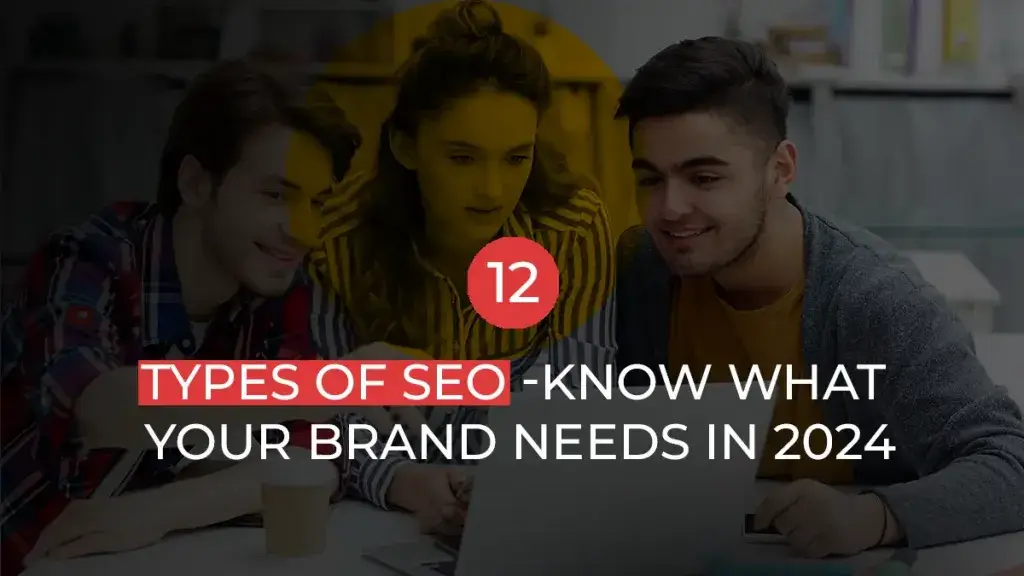12 Different Types Of SEO – Know What Your Brand Needs In 2025

Here's What We've Covered!
Have you ever wondered how does Google decide which content to put first for a search query and which should not be on the first page? Well, that’s where SEO comes into the picture. Search Engine Optimisation (SEO) refers to all those processes through which higher search visibility is achieved by a website. As you’ll come to know later in the blog, although keywords are a key element of your SEO efforts, SEO skills are more than just keyword research.
SEO is a concept that can be applied across all social media channels. It is a high-paying career option in Digital Marketing. This blog will cover 12 different types of SEO that are worth learning.
| Type of SEO | In a nutshell |
| On-page SEO | Any tweaks with respect to content that you do on the website to improve its reach and ranking is on-page SEO. |
| Off-page SEO | Off-page SEO includes activities you do off the website such as guest posting, forum posting, etc. to improve traffic, business, and ranking of your website |
| Technical SEO | The back-end work that improves the efficiency and appeal of your website is technical SEO. |
| Local SEO | It allows you to reach local audiences and improve your business’s appeal in a restricted geographical area. |
| Voice Search SEO | Making your websites responsive to voice commands. |
| eCommerce SEO | Employing on-page and off-page SEO techniques to improve the reach of your eCommerce website. |
| Black Hat SEO | Employing unethical means to climb the ladder and reach the top of search engines is black hat SEO. |
| Grey-Hat SEO | Neither ethical nor purely unethical SEO practices fall under grey-hat SEO. |
| Youtube SEO | Employ right techniques to reach masses with your video. |
| Programmatic SEO | This is a method that addresses growing amount of search traffic by publishing landig pages on a large scale.. |
| Content SEO | Create SEO-optimised content for your website. |
Now, let’s understand each of these types of SEO in detail.
12 Types Of SEO You Should Know in 2025
-
On-page SEO
As the name suggests, on-page SEO refers to all those efforts that you make on the web pages of your website to improve its visibility and ranking.
Let’s take an example, imagine you have an online store of trendy clothes, say tops, tees, shirts, jeans, etc for the 15-25 age group. Since this age group is most probably college students, you must understand the keywords they’re searching for while looking for clothes. Once done, you can infuse them on your product pages and assign a target keyword to each page of your website.
Moreover, you can write blogs showing the different ways you can style your products and use target keywords there too. Blogs if written with the right objectives and by employing the correct techniques can bring fruitful results. They’re an amazing way to infuse your target keyword in headlines and headers, title tags, headers, and meta descriptions.
All in all, you must devise a content plan for each stage of the customer journey.
What else can you do? You can put internal links to your product pages on your blog, home page, etc. Moreover, you can optimise your images by adding alt text, offering authentic images, creating categories and variants of product images, compressing them to ensure they load quickly, and more. You can even add structure to your content by adding the correct HTML tags in place.
In a nutshell, on-page SEO includes the following elements:
- Headlines and headers, title tags, meta description
- Image optimisation
- Internal linking
- On-page content strategy
- Structured data
- HTML Code, URL optimisation (basically shortening and infusing the right keyword in the URL to make it visible for the search engine and audience alike)
- Featured snippets and schema markup
Learn every type of SEO in just 3 months with Proschool’s Digital Marketing Course
-
Off-page SEO
Imagine you take your brick-and-mortar cake shop online. You create a fancy website showing all your delicacies and allowing your customers to book orders through the web itself. While on-page SEO is all about the things you can do on your website to improve its visibility and ranking, off-page SEO concerns itself with the promotion of your web content anywhere on the internet to drive the users to your web and improve traffic and business.
Always remember, that websites with high and steady traffic are more likely to earn goodwill from Google and get a better spot on its ranking page.
There are many ways through which you can improve your off-page SEO efforts. A few of them are mentioned below:
-
Link Building
Link Building or Backlinking is safe to say the crux of off-page SEO.
When Google sees your website getting backlinks from other quality websites, it improves your image (and your chances of ranking!).
-
Guest Blogging
Let’s take forth our previous example to understand this. Say you published a study on your NGO’s website. Now, you collaborate with a newspaper agency and write a piece for them around the same issue. In its digital version, you can give backlinks to your website and the original study and gain credibility from there too.
This way you can not only earn more credibility but boost traffic and visibility of your website!
-
Promotion
Let’s try this, search for “tops for women” or “shirts for men”. You are more likely to come across options from Ajio, Myntra, NykaaFashion, Amazon, or Flipkart.
Why do you think they get ranked on the first page (organically) and not the shopkeeper on your alleyway who always brags about being online?
Well, one way of looking at it is that those are big brands with better funds at their disposal. However, if you look at the other side of the picture, almost all of these platforms have a vast social presence, they regularly engage with their audience, and they promote their brand and its products in several ways.
All these efforts boost traffic to their site and their credibility in the eyes of Google.
-
HARO
This is one of the interesting ways to gain exposure. By solving the queries of journalists and reporters on HARO, you can gain much-needed media goodwill and backlinks that will boost your website’s online presence.
Also Read – Top 15 SEO Skills That Can Make You a Search Engine Wizard
-
Technical SEO
Another important type of SEO is Technical SEO. The ultimate goal of technical SEO is to enhance the user experience and make the website more accessible and user-friendly for both the search engine as well as the online audience.
There’s so much to technical SEO that it’s difficult to put it in a single blog. However mostly it includes the following:
- Site load time optimisation
- Improving mobile friendliness
- Keyword cannibalization audit
- Crawl error identification
- Duplicate content audit
- Creating XML sitemap and submitting it to all major search engines
- Optimising site and URL structure
- Employing robots.txt file for allowing Google to crawl your site effortlessly
- Using CDN for improving the loading speed of your web, etc.
-
Local SEO
If you have a small-scale business, knowing about local SEO is crucial.
Let’s suppose you have a bakery in Andheri and you sell cookies, namkeen, farsan and sweets. Since you only offer pick-up services, you want anyone who is searching for a “bakery in Andheri” to find your shop online.
Through local SEO you can reach the local audience by analysing their search behaviour and employing those keywords on your website.
All those practices of on-page and off-page SEO are also applicable here. However, a few things that you must make sure are as follows:
- Creating a Google My Business account
- Adding your business’s name, contact details and address to all the pages of your website.
- Adding the local business schema on your homepage
- Getting positive reviews on on local online directories and local websites
Also Read – 15 High Paying Digital Marketing Skills
-
Voice Search SEO
With the advent of voice search, more and more users are preferring it over the hassles of typing their query. In fact, voice assistants like Siri, Google Assistant, and Amazon Alexa are making voice search an inseparable part of our lives.
Thus, making your website responsive to voice commands is imperative in today’s times. If you’re working on voice search optimisation, here are a few things to keep in mind:
- Focus on conversational keywords
- Add relevant FAQs on your web pages
- Make your website mobile-friendly.
- Think local. Use local keywords to target your audience. Thus, when a customer asks for a “bakery in Andheri”, your website must pop up.
- Solve user’s queries without beating around the bush. A website that solves the user’s query as quickly as possible is deemed to get a high ranking in Google (given that other factors at play also synchronise).
Don’t know where & how to learn these types of SEOs?
-
eCommerce SEO
eCommerce is a very vast industry and nonetheless, a golden egg laying hen. However, when it comes to search engine optimization for eCommerce sites, it’s way more difficult than optimising a regular blog or corporate website. Why? They have plenty of pages to optimise, an abundance of target keywords to employ, tons of images to optimise, and whatnot. (Phew, that’s a LOT!)
Again the same on-page, off-page and technical SEO techniques would be required. Additionally, you can do the following things to organically improve your eCommerce platform’s visibility:
- Social Media: Develop a content strategy, and come up with new and creative ways to get your audience to your eCommerce site.
- Once they jump to your website, make your home page, category and product pages so impressive that it is hard to get off.
- Blogs: Publish SEO-optimised blogs off your product categories and keep them regularly updated. Right from the best ways to style a skirt to kitchen appliances you need in 2023, everything that you offer must be on your blog.
Also Read – Top 6 SEO Strategies That Have Evolved Big Time!
-
Black Hat SEO
Black hat SEO is all about the unethical means of succeeding by deceiving the search engine as well as the audience. Some common techniques employed in such SEO are as follows:
- Keyword stuffing: Unnecessarily stuffing keywords for the sake of higher reach.
- Cloaking: Presenting different content to both the search engine and the readers.
- Article spinning: Repurposing old or somebody else’s content by paraphrasing.
- Duplicate Content: Copy-pasting somebody else’s content (without their permission) on your website.
- Using paid links: Paying third-party platforms for backlinking.
- Content Farming: Publishing enormous amounts of low-quality articles for the sake of visibility in search engines.
Always remember, it’s deplorable to employ any of these SEO techniques.
Also Read – Top 13 Digital Marketing Trends
-
Grey-Hat SEO
Grey hat SEO can best be understood as neither entirely ethical (White hat SEO) nor entirely unethical (Black hat SEO) but something in between. Such tactics are used to generate quick results while steering clear from black hat SEO.
For instance, you might have come across clickbait content that compelled you to click on the link but after landing on the website, well, you regretted your decision, to say the least. Similarly, paid reviews and backlinks, and SEO squatting are a few other examples of grey-hat SEO techniques.
-
YouTube SEO
It’s safe to say that after Google our next saviour is YouTube. Be it last-minute exam preparation or current affairs, general fun videos to videos on complex issues, you name it, YouTube has it!
However, a lot of good connect creators need help to face the competition on YouTube. Thus, simply creating top-notch videos won’t get you to the masses unless you don’t master YouTube SEO.
YouTube algorithms are ever-expanding so it’s important to adopt the following techniques to level up your SEO game.
- Writing SEO-friendly titles and descriptions of videos
- Enriching the metadata of videos
- Enticing thumbnails with metadata
- Using meta tags and hashtags relevant to your video allows you to reach the masses
If you have a business, you can use YouTube to drive traffic to your website too. You can put the link to your website in the first comment, description or your profile.
Learn from industry professionals with years of experience of working with multi-billion dollar brands
-
Mobile SEO
There’s no denying that Google has become our one-stop solution for almost every query that we have (unless you’re living in China). In fact, it’s no more astonishing that more than 60% of searches on Google are done through mobile phones. Today, even Google has adopted a mobile-first index approach!
If you’re working on your Mobile SEO, the following are the few important things you must keep in mind:
- Ensuring a mobile-friendly website
- Enhancing the site loading speed
- Making your website quick to adapt to different devices
- A UI/UX design that works smoothly on mobile phones.
- Using keywords specific to mobile search on different pages of your website.
Also Read – How to crack your first job interview as a digital marketing professional
-
Content SEO
Content SEO is a subset of on–page SEO that primarily focuses on creating unique and interesting content that will allow you to rank higher on search engines.
If you want to master the game of content SEO, you need to work on this holy trinity:
- Copywriting: Writing short, crisp and up-to-the-point content for different pages of your website.
- Keyword strategy: Research the niche-specific keywords and use them in your content.
- Site structure: An impeccable site structure that allows Google to understand your site.
Remember in today’s competitive digital space, your content is your best bet on staying ahead of competitors, building better relations with customers and thereby ranking higher on search engines.
How to learn SEO?
If you want to learn SEO the hard way, resources are abundant on the internet. But, the problem is it is easier to get overwhelmed with all such information without proper guidance.
Thus, we suggest you check out our digital marketing course to learn SEO the smart way! With expert faculty teaching in in-person mode, a comprehensive syllabus and a focus on making you ready for jobs, your career is bound to take flight after completing the course! So hurry up and see whether IMS Proschool is in your location. (If not, no worries, we offer an online digital marketing course too!)
FAQs
1. Which type of SEO is best?
The “best” type of SEO depends on your specific goals and the nature of your website. Generally, a balanced approach that combines on-page, off-page, and technical SEO is most effective. Local SEO is crucial for businesses targeting a local market, while eCommerce SEO is essential for online stores. Voice Search SEO is increasingly important due to the rise of smart speakers and voice-activated devices.
2. What are the main types of SEO?
- On-page SEO: Involves optimizing the content on your website to improve rankings and reach.
- Off-page SEO: Includes activities done off the website, like guest posting and forum posting, to boost traffic and rankings.
- Technical SEO: Focuses on improving the back-end aspects of a website to enhance its efficiency and appeal.
- Local SEO: Targets local audiences to boost a business’s presence in a specific geographical area.
- Voice Search SEO: Optimizes a website to respond effectively to voice commands.
- eCommerce SEO: Combines on-page and off-page techniques to increase the visibility of an eCommerce site.
- Black Hat SEO: Involves unethical methods to quickly climb search engine rankings. It’s not recommended as it can lead to penalties.
- Grey-Hat SEO: Practices that are not entirely ethical but not outright black hat.
- YouTube SEO: Involves optimizing video content to increase visibility and reach on YouTube.
3. Why is SEO important?
SEO is crucial for increasing the visibility of your website in search engine results, which in turn can lead to more traffic, better user engagement, and increased conversions. Effective SEO strategies help in building brand awareness, credibility, and can significantly impact your business’s bottom line.
4. How to start SEO?
To start with SEO, first understand your audience and market. Conduct keyword research to find what your potential customers are searching for. Optimize your website’s content, structure, and on-page elements like meta tags and images according to these keywords. Build quality backlinks and focus on creating valuable content. Additionally, ensure your website is technically sound, with a fast loading speed, mobile responsiveness, and secure connections.
5. Is SEO a good career?
Yes, SEO is a promising career path. As the digital landscape continues to grow, the demand for skilled SEO professionals is increasing. It offers diverse opportunities ranging from technical SEO to content creation and digital marketing strategy. With the evolution of search engine algorithms and the increasing importance of online presence for businesses, SEO skills are highly valued
Resent Post
>
Best Study Abroad Courses for Commerce Graduates
>
Emerging commerce career options in India (2026): From CA to Data Analyst
>
ACCA Opportunities You Didn’t Know About – Think Beyond Audit!
>
Which Courses After 12th Commerce With High Salary Are in Demand Worldwide?
>
How to Find ACCA Jobs Online After Qualifying: Real Portals, Tips & Career Guidance
Follow Us For All Updates!



